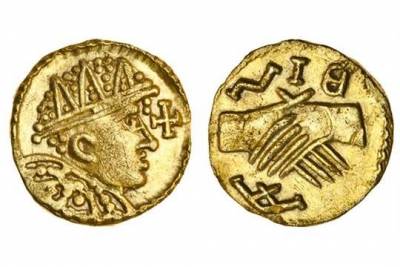
GREAT BEDWYN RESEARCH PROJECT, 2017
Residents of Great Bedwyn will have the chance to carry out small archaeological 'test pit' garden excavations to find out how the area has developed over hundreds-even thousands-of years. It's a great chance for the community to get together to make new discoveries.
Great Bedwyn and its environs are rich in historical and archaeological sites and monuments from prehistoric times up to the recent past and the remarkable heritage that survives from the Industrial Revolution. While later periods leave the most visible remains today, there is an untapped resource awaiting investigation which has the potential to throw new light on the enigmatic early history of Bedwyn. Bedywn is recorded as a mint in the Domesday Survey of 1086 and it is one of 112 places categorized as a borough-or town-nationally at that time. A century earlier, the place is recorded as a possession of the Abbey of Abingdon, whose foundation story includes a fascinating note purporting to relate to early Bedwyn. According to a 12th century document, a certain King Cissa gave land for the foundation of Abingdon Abbey between AD 674 and 685, while a document of a century later records that Cissa ruled from Bedwyn and gave his name to the close by Chisbury hillfort. One must be careful about accepting the validity of such early suggestions, but Bedwyn's importance before the Norman conquest of 1066 is without doubt. It had a church by 1066 and is it only one of four places in Anglo-Saxon England known to have had a guild (the others being Cambridge, Exeter and London).
It is possible that the layout of the present village reflects that of a thousand or more years ago, but of this we cannot be certain without uncovering new evidence. To this end, we would like to engage in collaboration with the people of Bedwyn in a campaign of investigations in the summer of 2017. Our recent talk to the Bedwyn Historical Society has generated much interest and we are already in touch with people who have offered us the chance to dig a small hole (1m sq) in their gardens. Similar work elsewhere in England has shown that if sufficient holes can be dug across the space occupied by a village, then much can be said about the origins and development of a place. We hope too, to undertake geophysical surveys in any available ground (entirely non-destructive) and perhaps to dig a few larger holes in particularly promising places.
Proposal: Test pitting event in Bedwyn for two weeks from 10 July 2017.
We want to hear from you if you can either host a test pit in your garden/land or would like to take part in the test pit digging as a volunteer and dig in someone's garden.
Test pits are just 1m², create a minimum of disturbance to your garden, and can be sited anywhere you wish. The digging can be done by you, your family and friends, or by others. Full instructions and expert support are provided throughout. It's a fun way to get together and make new discoveries about the past beneath your feet in Great Bedwyn!
What will happen over the week:
- Test pits are just 1m² and create a minimum of disturbance.
- They can be sited anywhere you wish (on unscheduled land).
- The digging can be done by you, your family and friends, or by local school pupils or by interested members of the public from elsewhere.
- Property owners who aren't digging their own pit don't have to be present during the excavation, although you're welcome to get involved with the excavations and 'your' digging team if you want to.
- Finds are washed and recorded and retained for analysis, after which they will be returned to property owners, if requested.
- The small amount of spoil created is sieved onto tarpaulins, preventing damage to lawns.
- Test pits are completed in two days and back-filled, with any turf replaced neatly. The site should be invisible within a few weeks.
- Results will be communicated to everyone who's interested via this webpage, written reports and a follow-up talk.
How can I get involved?
- You can dig your own test pit in your own garden/property in Bedwyn
- You can offer your garden/property in Bedwyn for someone else to dig
- You can offer to dig someone else's garden/property in Bedwyn
- You can offer digging equipment for someone else to borrow
- You can help by manning a tent and/or preparing refreshments for diggers over the weekend
What do I do next?
- To register to take part contact Prof Andrew Reynolds: a.reynolds@ucl.ac.uk or phone: +44 (0)20 7679 1522
- Talk to friends, family etc. to see who else would like to join in, either with you or on their own pit.
- Keep in touch with the organisers so they know that you know what's going on, and who has confirmed they're going to take part
- Think about where you might want to dig, what equipment you have and what you'll want to borrow or lend.
- Spread the word and encourage others to get involved!
- For further information keep an eye on this website!
Contacts:
Prof Andrew Reynolds and Dr Stuart Brookes
Email: a.reynolds@ucl.ac.uk, s.brookes@ucl.ac.uk
Phone: 0207 679 1522; 0207 679 4790
Post: UCL Institute of Archaeology, 31-4 Gordon Square, London WC1H 0PY
 Close
Close

